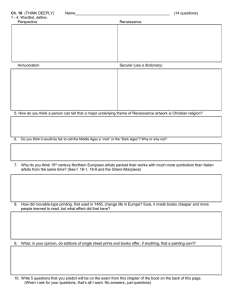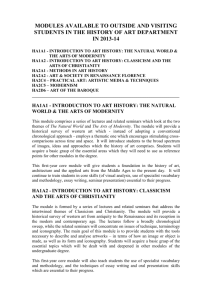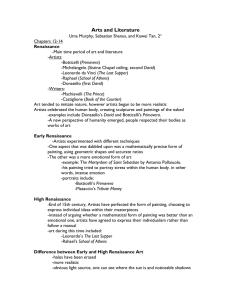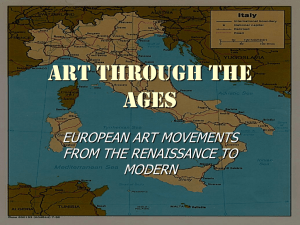test2ss7thed.doc
advertisement
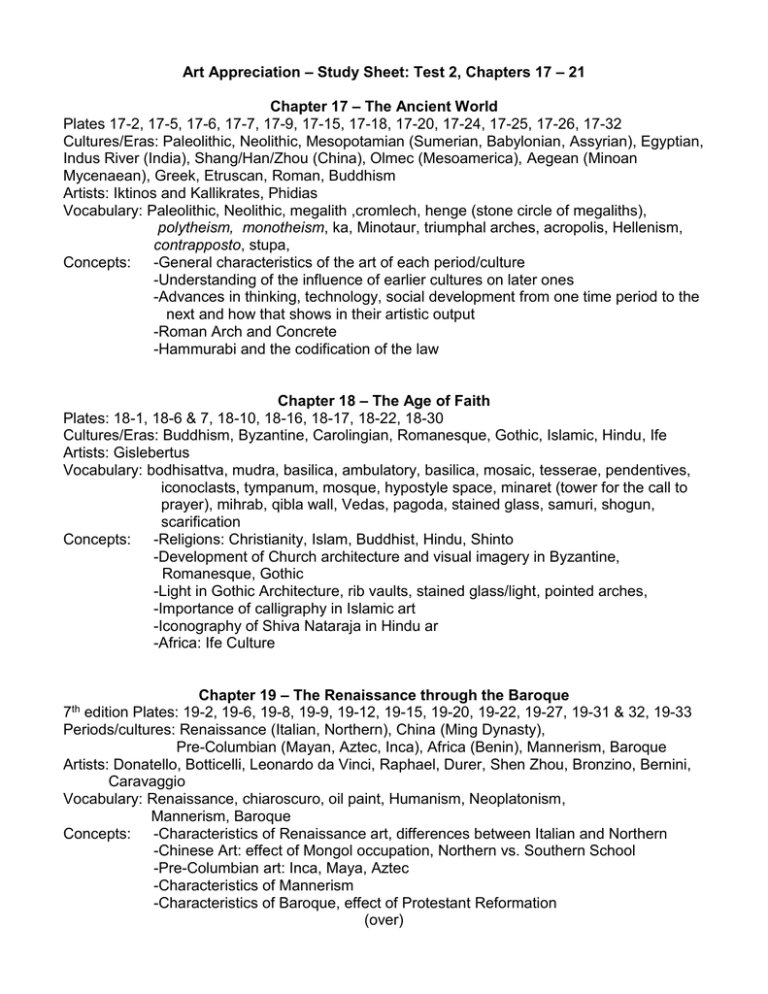
Art Appreciation – Study Sheet: Test 2, Chapters 17 – 21 Chapter 17 – The Ancient World Plates 17-2, 17-5, 17-6, 17-7, 17-9, 17-15, 17-18, 17-20, 17-24, 17-25, 17-26, 17-32 Cultures/Eras: Paleolithic, Neolithic, Mesopotamian (Sumerian, Babylonian, Assyrian), Egyptian, Indus River (India), Shang/Han/Zhou (China), Olmec (Mesoamerica), Aegean (Minoan Mycenaean), Greek, Etruscan, Roman, Buddhism Artists: Iktinos and Kallikrates, Phidias Vocabulary: Paleolithic, Neolithic, megalith ,cromlech, henge (stone circle of megaliths), polytheism, monotheism, ka, Minotaur, triumphal arches, acropolis, Hellenism, contrapposto, stupa, Concepts: -General characteristics of the art of each period/culture -Understanding of the influence of earlier cultures on later ones -Advances in thinking, technology, social development from one time period to the next and how that shows in their artistic output -Roman Arch and Concrete -Hammurabi and the codification of the law Chapter 18 – The Age of Faith Plates: 18-1, 18-6 & 7, 18-10, 18-16, 18-17, 18-22, 18-30 Cultures/Eras: Buddhism, Byzantine, Carolingian, Romanesque, Gothic, Islamic, Hindu, Ife Artists: Gislebertus Vocabulary: bodhisattva, mudra, basilica, ambulatory, basilica, mosaic, tesserae, pendentives, iconoclasts, tympanum, mosque, hypostyle space, minaret (tower for the call to prayer), mihrab, qibla wall, Vedas, pagoda, stained glass, samuri, shogun, scarification Concepts: -Religions: Christianity, Islam, Buddhist, Hindu, Shinto -Development of Church architecture and visual imagery in Byzantine, Romanesque, Gothic -Light in Gothic Architecture, rib vaults, stained glass/light, pointed arches, -Importance of calligraphy in Islamic art -Iconography of Shiva Nataraja in Hindu ar -Africa: Ife Culture Chapter 19 – The Renaissance through the Baroque edition Plates: 19-2, 19-6, 19-8, 19-9, 19-12, 19-15, 19-20, 19-22, 19-27, 19-31 & 32, 19-33 Periods/cultures: Renaissance (Italian, Northern), China (Ming Dynasty), Pre-Columbian (Mayan, Aztec, Inca), Africa (Benin), Mannerism, Baroque Artists: Donatello, Botticelli, Leonardo da Vinci, Raphael, Durer, Shen Zhou, Bronzino, Bernini, Caravaggio Vocabulary: Renaissance, chiaroscuro, oil paint, Humanism, Neoplatonism, Mannerism, Baroque Concepts: -Characteristics of Renaissance art, differences between Italian and Northern -Chinese Art: effect of Mongol occupation, Northern vs. Southern School -Pre-Columbian art: Inca, Maya, Aztec -Characteristics of Mannerism -Characteristics of Baroque, effect of Protestant Reformation (over) 7th Chapter 20 – The Eighteenth and Nineteenth Centuries Plates: 20-9, 20-13, 20-14, 20-19, 20-22, 20-24, 20-34 Periods/Styles – Rococo, Neoclassical, Romanticism, Realism, Impressionism, Post-Impressionism Artists: David, Goya, Gericault, Courbet, Manet, Monet, Cezanne Vocabulary: Rococo, salon, Neoclassicism, Romanticism, sublime, Realism, Impressionism, Post-Impressionism Concepts: -Characteristics of each period/style in terms of form and content -Relationship of styles to reality (idealism, realism, increasing abstraction) Chapter 21 – From 1900 to the Present Plates: 21-3, 21-11, 21-14, 21-17, 21-19, 21-22, 21-31 Artists: Matisse, Dali, Picasso, Hopper, Willem de Kooning, Lichtenstein, Frida Khalo, Vocabulary/Periods: Cubism, Fauvism, Expressionism, Futurism, Dada, Surrealism, Modernism, Abstract Expressionism, Pop Art, Minimalism, Post-Modernism, automatism Concepts: -Characteristics of the styles: What made them innovative, how they questioned assumptions, what they tried to accomplish or communicate


